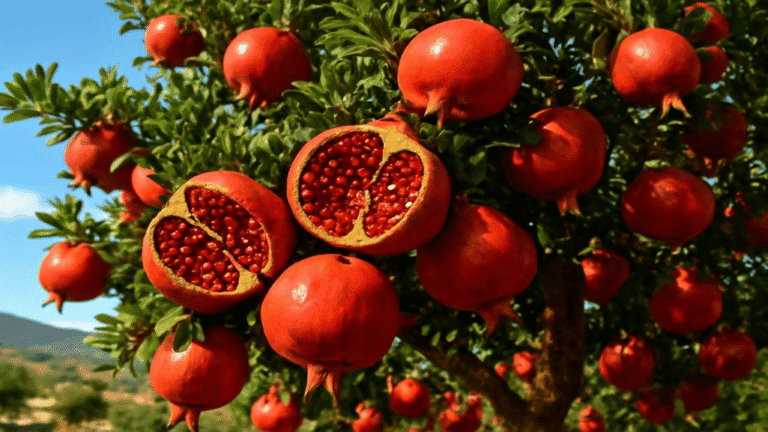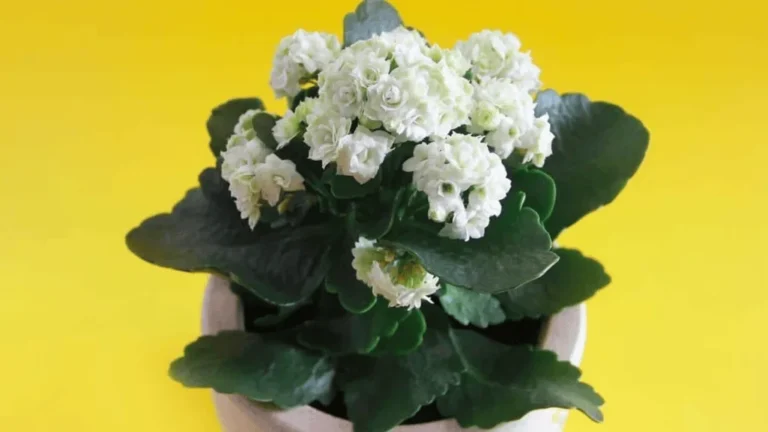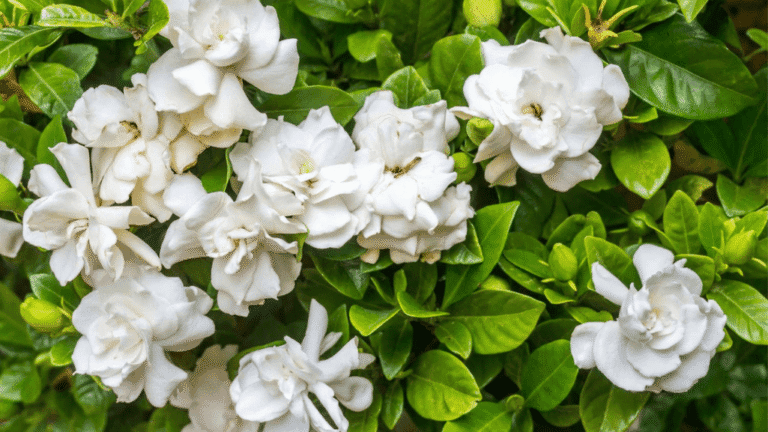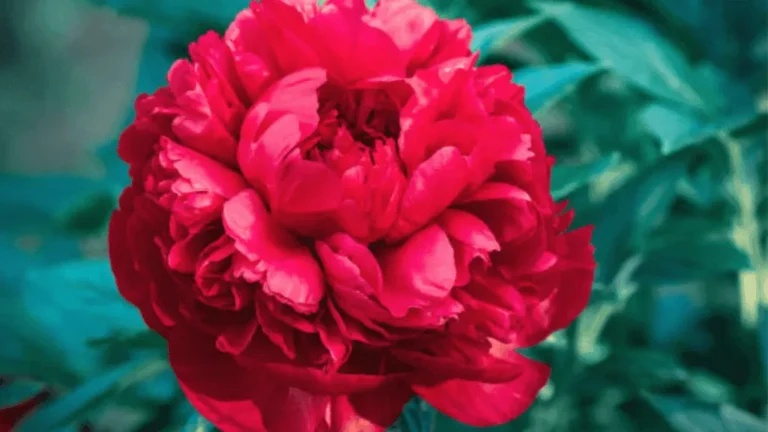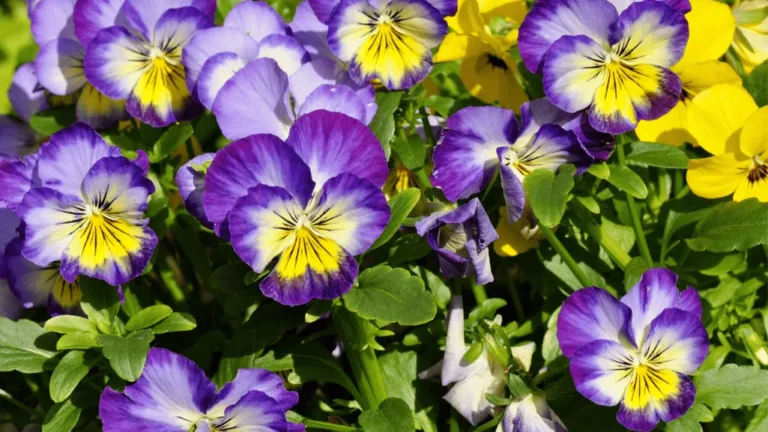Beautiful flowers gardenia Plants For Your homes

Gardenias are a top choice for garden lovers wanting a beautiful and scented outdoor area. These evergreen shrubs, from tropical areas, are known for their beauty and sweet smell. They have shiny, dark green leaves and lovely white flowers, adding elegance to any garden.
Gardenias, scientifically named Gardenia jasminoides, are part of the Rubiaceae family. They’re famous for their sweet scent. For centuries, they’ve been grown in Asia and now are loved worldwide. They come in different sizes and shapes, fitting any garden style.
Gardenias bloom for a long time, from late spring to summer. They keep their beauty and scent going. Their white petals are soft and look beautiful, making them a joy to touch.
Key Takeaways
- Gardenias are elegant evergreen shrubs with glossy foliage and fragrant white flowers.
- Native to tropical regions, gardenias are versatile and come in various sizes and growth habits.
- Gardenias are repeat bloomers, producing flowers from late spring through summer.
- The scientific name for gardenias is Gardenia jasminoides, belonging to the Rubiaceae family.
- Gardenias are prized for their intoxicating fragrance and have a rich history of cultivation.
Introduction to Gardenias
Gardenias are captivating ornamental plants that have charmed gardeners and nature lovers for centuries. These evergreen shrubs, known as Gardenia augusta, are famous for their shiny green leaves and sweet-smelling white flowers. They come from the tropical parts of Africa, Asia, and the Pacific Islands and are now loved in gardens all over the world.
What are Gardenias?
Gardenias are evergreen shrubs in the Rubiaceae family, which also includes coffee and quinine. They can grow 3 to 8 feet tall, spreading equally wide. These plants are grown for their fragrant flowers and attractive leaves. They bloom from May to June and sometimes in the summer.
Their flowers are stunning, measuring 2 to 4 inches wide and can be single or double. The white petals have a strong scent, making gardenias popular for perfumes and aromatherapy. Gardenias grow well in moist, well-drained soil that’s rich and acidic. They prefer full sun or afternoon shade.
| Characteristic | Description |
|---|---|
| Height | 3 to 8 feet |
| Spread | Usually about the same as the height |
| Flower Size | 2 to 4 inches in diameter |
| Flower Type | Single or double, waxy, white, and very fragrant |
| Growth Rate | Medium |
| Blooming Period | May through June and sporadically throughout the summer |
Origin and History of Gardenias
The story of gardenias is as intriguing as the plants themselves. Before reaching Europe, they were found in China, Japan, and Korea. In 1752, Dr. Alexander Garden, a Scottish doctor and naturalist, moved to Charleston, South Carolina. His letters to English botanist John Ellis led to the naming of the genus Gardenia in his honor in 1758.
Gardenia jasminoides, the most common type, has been grown in China for over a thousand years. It was introduced to English gardens in the mid-18th century and later became popular in the Southern United States. Gardenias don’t do well in Northern winters and love the South, often used for corsages and decorations.
Today, gardenias still enchant gardeners and plant lovers globally. With their sweet scent, shiny leaves, and timeless beauty, these evergreen shrubs are a favorite in gardens and landscapes.
Types of Gardenias
There are over 200 types of gardenias for gardeners to pick from. Each type has its own size, bloom time, and hardiness. It’s important to think about these when choosing a gardenia. Gardenias grow best in USDA Zones 6 to 11. Some can even grow in Zones 7 to 11, and a few in Zones 10 to 11.
Common Gardenia Varieties
Gardenia jasminoides is a top choice for its sweet-smelling white flowers and shiny leaves. Some popular types include:
- ‘August Beauty’: This type can reach 6 feet tall and thrives in USDA zone 7.
- ‘Kleim’s Hardy’: It grows 2 to 3 feet tall and has single-petaled flowers with bright yellow centers.
- ‘Mystery’: Hardy up to zone 8, it stands about 5 feet tall and blooms from spring to fall with double, white flowers.
- ‘First Love’: A smaller variety that grows 5 feet high, blooms early in spring, and has some of the biggest double flowers.
Other popular types are ‘Crown Jewel’ and ‘Radicans’, known for being cold hardy and small in size.
Rare and Exotic Gardenia Species
There are also rare and exotic gardenia species with special features:
- Gardenia thunbergia: This species has big, tube-shaped flowers and can grow up to 15 feet tall, native to South Africa.
- Gardenia taitensis: Known as the Tahitian gardenia, it has a strong scent and white flowers, from the South Pacific islands.
- Gardenia radicans: A dwarf type with double flowers, from Japan, reaching 24 to 36 inches tall.
| Variety | Height | Width | Bloom Time | Flower Type | Hardiness |
|---|---|---|---|---|---|
| ‘First Love’ | 5-8 feet | 3-6 feet | Early spring | Double, large | Zones 7-11 |
| ‘Radicans’ | 24-30 inches | 24-30 inches | Late spring-early summer | Single, creamy white | Zones 7-11 |
| ‘Mystery’ | 5 feet | 5 feet | Spring-fall | Double, white | Zones 8-11 |
Gardeners can find the perfect gardenia for their needs, whether it’s a small, cold-hardy type or a rare, exotic one with unique flowers.
Gardenia Care and Maintenance
To keep your gardenias thriving, give them the right care and maintenance. They need specific growing conditions. With proper attention to soil, watering, fertilizing, and pruning, your gardenias will be healthy and bright. Southern Living has great tips for these beautiful shrubs.
Soil Requirements for Gardenias
Gardenias love soil that drains well and is acidic, with a pH of 4.5 to 6.0. Add compost or peat moss to the soil for better moisture and nutrients. Don’t plant them in heavy clay or poor drainage areas to avoid root rot.
Watering and Fertilizing Gardenias
Gardenias need about an inch of water each week to grow well. Water them deeply and often, especially when it’s dry. Feed them a special fertilizer every month from spring to late June. Use a slow-release fertilizer as the package says to feed them all season.
| Fertilization Schedule | Timing |
|---|---|
| First Application | Mid-March |
| Second Application | Late June |
| Stop Feeding | Fall (before dormancy) |
Pruning and Shaping Gardenias
Pruning is key to keeping your gardenias looking good and healthy. Cut them right after they bloom to keep the next season’s flowers coming. Remove dead, damaged, or sick branches to keep air moving and the plant strong. When shaping your gardenias, remember:
- Use clean, sharp tools to prevent spreading disease
- Cut just above a leaf node or branch junction
- Don’t prune too much to keep flowers and health
- Remove spent blooms to keep them flowering all season
By following these tips, your gardenias will stay healthy and full of blooms. With the right care, these lovely shrubs will give you beautiful flowers and a sweet scent every year.
Planting Gardenias in Your Garden
Choose a spot that gets partial sun for your gardenias. They do well in morning sun and afternoon shade, especially in zones 9 and 10. It’s important to have well-draining soil, as they like acidic soil with a pH of 5 to 6. Use compost or peat moss to improve drainage and keep the soil acidic.
When planting several gardenia shrubs, make sure to space them out. The size of the plant will determine how far apart they should be. For example, August Beauty Gardenias can grow up to 4 feet tall and 4 to 5 feet wide. Kleim’s Hardy Gardenias stay smaller, at 2 to 3 feet tall and wide. Check the Old Farmer’s Almanac for the best spacing for your gardenia type.
When you plant your gardenias, dig a hole that’s twice as wide as the root ball. This gives the roots room to grow. Water them well and add mulch around the base. Mulching keeps the soil moist, controls temperature, and stops weeds from growing, which helps your gardenias stay healthy.
| Gardenia Variety | Mature Size | Spacing |
|---|---|---|
| August Beauty | 4 ft tall, 4-5 ft wide | 4-5 ft apart |
| Frost Proof | 4 ft tall, 3 ft wide | 3-4 ft apart |
| Jubilation™ | 2-3 ft tall and wide | 2-3 ft apart |
| Kleim’s Hardy | 2-3 ft tall and wide | 2-3 ft apart |
Keep the soil moist but not too wet, especially the first year. Gardenias need about one inch of water per week. With the right care, you’ll get lots of beautiful, fragrant flowers all season.
Growing Gardenias in Containers
Container gardening is a great way to enjoy gardenias’ beauty and fragrance, even in small spaces or cooler areas. By planting gardenias in pots, you can move them inside during winter to keep them warm. This lets you enjoy their beauty on your patio, porch, or terrace in the warmer months.
Choosing the Right Container for Gardenias
Choose a pot that’s 2 to 3 times bigger than the plant’s root ball for your gardenia. This gives the roots enough room to grow and get the nutrients and moisture they need. Gardenias do well in large containers because they stay more stable and have better growing conditions.
Think about these things when picking a container for your gardenia:
- Size: Pick a pot that can hold 2 to 3 years of growth before needing a bigger one.
- Material: Terra cotta, ceramic, or plastic pots work well, each with their own benefits like weight, durability, and how they handle moisture.
- Drainage: Make sure the container has enough holes for drainage to prevent waterlogging and root rot.
Potting Soil and Drainage for Container-Grown Gardenias
Gardenias need a potting mix that drains well and is a bit acidic, with a pH of 5 to 6.5. Most potting mixes made for containers are good for gardenias because they help with drainage and acidity.
Here are some tips to improve drainage:
- Add perlite or pumice to the soil to help with aeration and prevent it from getting too dense.
- Put a layer of gravel or broken pottery at the bottom of the container to help with drainage.
- Water your gardenia only when the top inch of soil feels dry to prevent overwatering.
| Soil Property | Ideal Range for Gardenias |
|---|---|
| pH | 5.0 to 6.5 |
| Drainage | Well-draining, about 1 inch per hour |
| Moisture | Moist but not constantly soggy |
By choosing the right container size, potting mix, and drainage, you can grow gardenias in pots successfully. This way, you can enjoy their beautiful blooms and lovely scent in different places.
Gardenias as Indoor Plants
Gardenias are great both outside and inside. They have shiny leaves and sweet-smelling white flowers. To keep them happy indoors, you need to give them the right care and conditions.
Providing Optimal Indoor Conditions for Gardenias
For indoor gardenias, try to match their outdoor home as much as you can. They love bright, indirect light and like it when the air is moist. Put your gardenia near a window that gets lots of light but not direct sun, which can burn the leaves. They need at least four hours of sunlight a day to grow well and bloom.
Temperature is also key for gardenias inside. They do best in cool temperatures, around 64°F (18°C) in the day and 55°F (13°C) at night. Keep them away from cold drafts or heat sources to prevent stress and losing buds.
Humidity is crucial for gardenias inside too. They like the air to be about 50% humid. You can raise the humidity by putting a tray of water under the plant, using a humidifier, or misting the leaves. Or, you can keep your gardenia in a humid room like a bathroom if it gets enough light.
Caring for Indoor Gardenias
Watering is important for gardenias inside. They like their soil to be moist but not soggy. Check the soil by sticking your finger in it, and water when it feels dry on top. Cut back on watering in the winter when the plant is dormant.
Feeding your gardenia with the right food helps it grow and bloom. Use a balanced fertilizer made for acid-loving plants, like a 20-20-20 mix. Feed your gardenia every two to four weeks when it’s growing, following the instructions on the fertilizer package. Don’t overfeed, as it can harm the roots.
Pruning is a must to keep your gardenia looking good. Cut off any dead flowers and leaves to keep it neat and encourage new growth. Prune after it blooms to help it grow fuller and have more flowers next time.
| Indoor Gardenia Care | Recommendations |
|---|---|
| Light | Bright, indirect light; minimum 4 hours per day |
| Temperature | 64°F (18°C) day, 55°F (13°C) night; avoid drafts and heat sources |
| Humidity | Around 50%; use a tray of water, humidifier, or mist leaves |
| Watering | Keep soil consistently moist but well-drained; reduce in winter |
| Fertilizing | Use a balanced, water-soluble fertilizer every 2-4 weeks during growing season |
| Pruning | Remove faded flowers and yellowing leaves; prune after flowering for shape |
With the right care, your indoor gardenia can be beautiful and fragrant all year. Just give it some attention and wait patiently, and it will become a lovely part of your home.
Propagating Gardenias
Expanding your gardenia collection is easy with propagation. The best way to do this is through stem cuttings. Take cuttings between July and October when the plant is growing well and not blooming.
Choose healthy stems with 4 to 5 leaf nodes for cuttings. Cut off the lower leaves, leaving two sets at the top. Then, dip the cut end in rooting hormone to help roots grow.
Plant the cuttings in a potting mix that drains well. Keep the area humid for 6 to 8 weeks as roots develop. Use a clear plastic bag or a humidity tray to keep it moist.
Don’t let the soil get too wet, as this can cause rot. Finding the right balance takes time, so be patient.
Roots should appear in 6 to 8 weeks, depending on the gardenia type. Check for roots by gently tapping or rinsing the cutting. Once roots are strong, slowly get them used to normal conditions by reducing humidity and increasing light.
With the right care, your gardenias will grow well and soon you’ll enjoy their beautiful leaves and sweet scent. They’ll add elegance to your tropical garden.
| Gardenia Variety | Price |
|---|---|
| Frost Proof Gardenia Shrub | $17.76 |
| Kleim’s Hardy Gardenia Shrub | $29.95 |
| Dwarf Gardenia Radicans Shrub | $29.99 |
Note: Prices may vary depending on the supplier and the size of the plant.
Common Pests and Diseases Affecting Gardenias
Gardenias are beautiful and fragrant but face many pests and diseases. Knowing these issues helps keep your gardenias healthy. It’s key to spot and manage these problems early.
Identifying and Treating Gardenia Pests
Several pests can harm gardenias, like:
- Spider mites: These tiny arachnids create webbing on leaves and cause damage.
- Mealybugs: These insects look like white cotton on leaves and stems, leading to yellowing.
- Whiteflies: These small, white insects fly and feed on sap, causing yellowing and leaf drop.
- Scales: Adult female scales attach to leaves and suck sap, causing yellowing and dieback.
- Aphids: These aphids vary in color and can be green, yellow, pink, or black.
To fight these pests, try these steps:
- Check plants for signs like webs, sticky residue, or discolored leaves.
- Use insecticidal soap or horticultural oil sprays as needed.
- Apply a 1% horticultural oil mix to control scales when new growth appears.
- Use specific insecticides against scales, following label instructions.
- Apply soil insecticides for controlling scales.
- Hose off aphids or use sprays for control.
Preventing and Managing Gardenia Diseases
Gardenias can get several diseases, such as:
- Root rot: Caused by pathogens, it leads to wilting and stunted growth.
- Leaf spot: Fungal diseases cause spots on leaves, leading to leaf drop.
- Powdery mildew: This disease appears as a white coating on leaves and shoots.
- Stem canker: Caused by Phomopsis gardeniae, it results in wilting and stunted growth.
- Sooty mold: This fungus grows as a black coating on leaves, thriving on honeydew.
To prevent and manage these diseases:
- Ensure good drainage and avoid overwatering to prevent root rot.
- Keep air moving by spacing plants well.
- Remove and dispose of affected leaves or branches to stop disease spread.
- Use fungicides like myclobutanil for specific diseases.
- Control sap-sucking insects to stop sooty mold growth.
| Pest/Disease | Symptoms | Control Measures |
|---|---|---|
| Spider mites | Webbing, stippling, discoloration | Insecticidal soap, horticultural oil |
| Mealybugs | White, cottony masses, yellowing, stunted growth | Insecticidal soap, horticultural oil |
| Whiteflies | Small white flying insects, yellowing, leaf drop | Insecticidal soap, horticultural oil (3 times at 5-7 day intervals) |
| Scales | Small, immobile insects, yellowing, branch dieback | Horticultural oil (2 times at 5-6 week intervals), specific insecticides |
| Aphids | Small, soft-bodied insects in various colors | Hosing off with water, insecticidal soap, horticultural oil |
| Root rot | Wilting, yellowing, stunted growth | Ensure proper drainage, avoid overwatering |
| Leaf spot | Circular or irregular spots on leaves | Remove affected leaves, improve air circulation |
| Powdery mildew | White, powdery coating on leaves and shoots | Fungicides (myclobutanil, thiophanate-methyl, chlorothalonil, propiconazole) |
| Stem canker | Wilting, yellowing, leaf drop, stunted growth | Remove affected branches, improve air circulation |
| Sooty mold | Black, sooty coating on leaves | Control sap-sucking insects to prevent honeydew buildup |
Stay alert and act fast to keep your gardenias healthy. This way, you’ll enjoy beautiful, fragrant blooms in your garden.
Companion Plants for Gardenias
Choosing the right plants to go with gardenias is key for a beautiful garden. The right mix can make your garden look better and add contrast and texture.
Gardenias love acidic soil with a pH of 5.0. They do well with plants that need the same conditions. Rhododendrons, azaleas, and camellias also like full sun in the morning and shade later. These evergreens make a great background for gardenias, adding beauty all year.
Complementary Flowers and Foliage for Gardenia Beds
To make your gardenia beds pop, try these plants:
- Foliage plants: Caladiums, ferns, and hostas add nice contrast with their leaves.
- Flowering plants: Impatiens, begonias, and azaleas bring colors that match gardenias well.
- Evergreen shrubs: Boxwood, yew, and false cypress work well behind gardenias, offering structure and interest all year.
| Companion Plant | Characteristics | Benefits |
|---|---|---|
| Azaleas | Evergreen, colorful blooms | Similar growing requirements, provides contrast |
| Camellias | Evergreen, glossy foliage, flowers | Shared growing conditions, creates a stunning backdrop |
| Ferns | Lush, textured foliage | Adds visual interest and contrast to gardenia beds |
| Hostas | Varied leaf shapes and colors | Provides foliage contrast and thrives in similar conditions |
When picking plants for gardenias, skip fragrant ones like Asiatic lilies and roses. They might mask the gardenia scent. Also, cacti and succulents don’t do well in the humid, acidic soil gardenias prefer.
Choosing plants that grow well together and add variety can make your garden look amazing. This way, you highlight the beauty of gardenias in your landscape design.
Using Gardenias in Floral Arrangements
Gardenias are a top pick for floral design because of their beauty and sweet smell. They make any arrangement look more elegant and romantic. Adding gardenias to your cut flowers collection can make any bouquet, centerpiece, or boutonniere look amazing.
Tips for Cutting and Arranging Gardenia Blooms
Here are some tips for using gardenias in your arrangements:
- Choose blooms that are almost fully open for the best look and smell.
- Cut the stems at an angle and put them in water right away to keep them fresh.
- Pair gardenias with flowers like roses, lilies, or greenery for a balanced look.
- Try different gardenia types, like ‘Mystery’ or ‘Variegata’, to add variety to your designs.
Preserving Gardenia Flowers
Fresh gardenias are beautiful, but you can also keep their beauty for longer. Here are two ways to flower preservation:
- Pressing: Put gardenia blooms between book pages, making sure they’re flat and dry. Leave them alone for weeks until they’re dry.
- Drying with silica gel: Cover the blooms with silica gel crystals in a sealed container. Wait a few days until they’re completely dry.
After preserving, you can use the gardenia blooms in crafts like pressed flower art, resin jewelry, or framed displays.
| Floral Design Style | Recommended Gardenia Varieties |
|---|---|
| Classic and Elegant | First Love, Mystery, August Beauty |
| Rustic Charm | Kleim’s Hardy, Chuck Hayes |
| Modern and Minimalistic | Variegata, Radicans |
| Lush and Luxurious | Aimee Yoshioka, Golden Magic |
| Bohemian Chic | Four Seasons, Daisy |
Gardenias are perfect for both professional florists and home gardeners who love arranging flowers. They are always in style. Try different types, styles, and ways to preserve them to make beautiful displays that show off their beauty.
Gardenias in Perfumery and Aromatherapy
Gardenias are a favorite in the perfume world for their sweet, complex smell. The gardenia essential oil is a key ingredient in luxury perfumes and candles. It’s known to help you relax, reduce stress, and boost your mood. This makes it a top choice for natural perfumes and scented items like soaps and lotions.
For over thirty years, gardenia essential oils have been made from the flowers. They’re used to make gifts like potpourri and essential oils for crafts. The traditional enfleurage method presses the flowers between glass sheets to transfer their fragrance into oil. This creates a strong, true gardenia essential oil.
While gardenias are a top pick for making perfumes, other flowers can also be used. These include:
- Magnolias
- Roses
- Lily-of-the-valley
- Lavender
- Lilacs
Not just flowers, but herbs and spices can also be used to make scented oils. This gives a wide range of fragrances to choose from:
| Herbs | Spices |
|---|---|
| Sweet marjoram | Cinnamon |
| Lemon verbena | Cardamom |
| Oregano | Ginger |
| Basil | Nutmeg |
| Allspice | |
| Cloves |
Gardenias are used in perfumery in places like La Réunion, Sri Lanka, and Grasse. In Colombia, they use enfleurage to make the beautiful Gardenia fragrans oil. Famous perfume experts Luca Turin and Tania Sanchez love the Gardenia enfleurage for its light, pleasant smell. They also notice a unique “mushroom hologram” note in it.
When using essential oils for aromatherapy or personal care, always dilute them first. And never take them by mouth. If you have a weak immune system, talk to a professional before using essential oils. This ensures they’re safe for you.
Conclusion
Gardenias make any garden look stunning with their beauty and sweet smell. They have shiny leaves and beautiful white flowers. With the right care, gardenias can grow well in many places, like gardens, pots, or even inside your home.
For gardenias to grow well, they need certain things. They like soil that drains well and is a bit acidic, with a pH of 5.0 to 6.5. They also like daytime temperatures between 60 to 70 degrees Fahrenheit and cooler nights, around 50 to 60 degrees.
It’s important to water, feed, and trim your gardenias regularly. You should also protect them from pests and diseases. Following these tips will help your gardenias thrive. For more details on how we handle visitor data, check out our privacy policy.
Adding gardenias to your garden is a great choice, whether you’re a pro or just starting. These lovely flowers make your garden look better and smell amazing. They turn your garden into a peaceful and elegant place.






